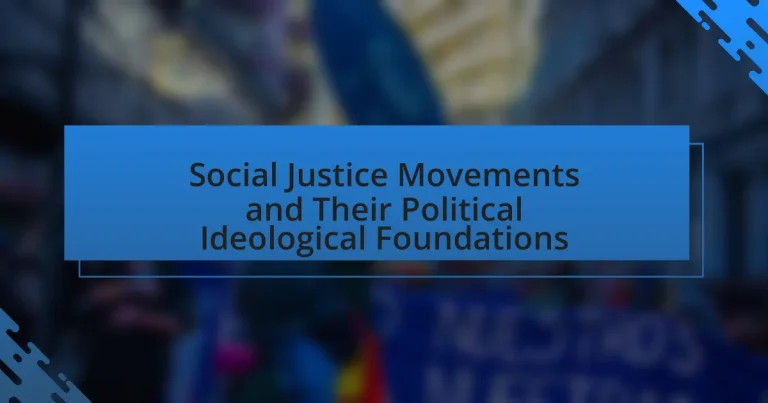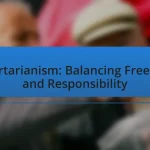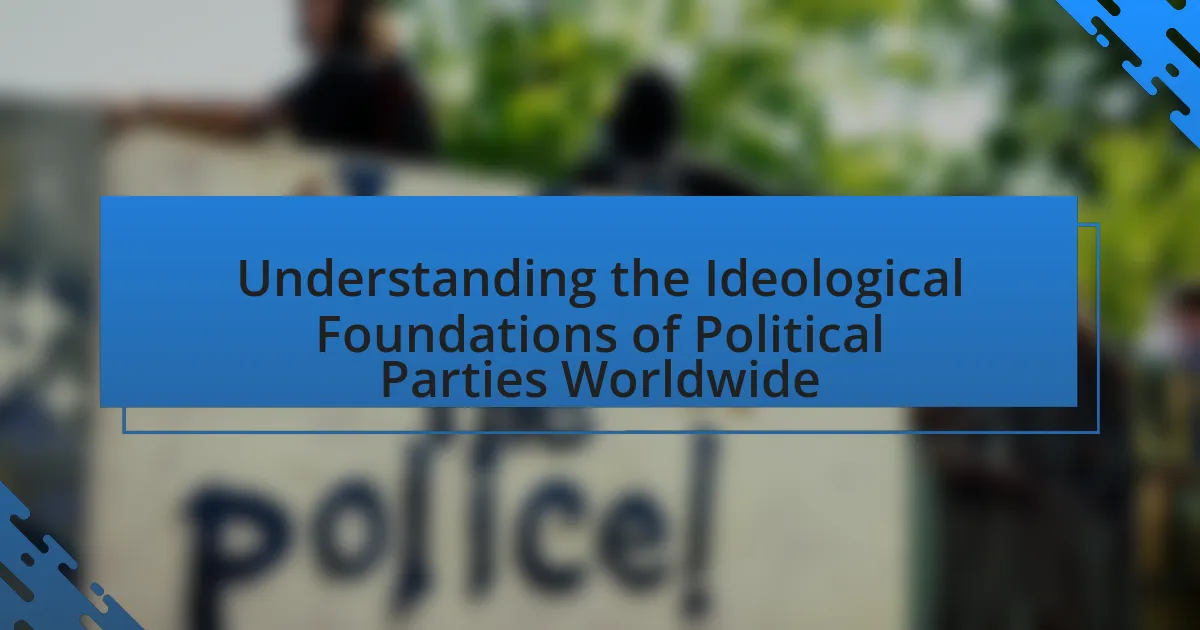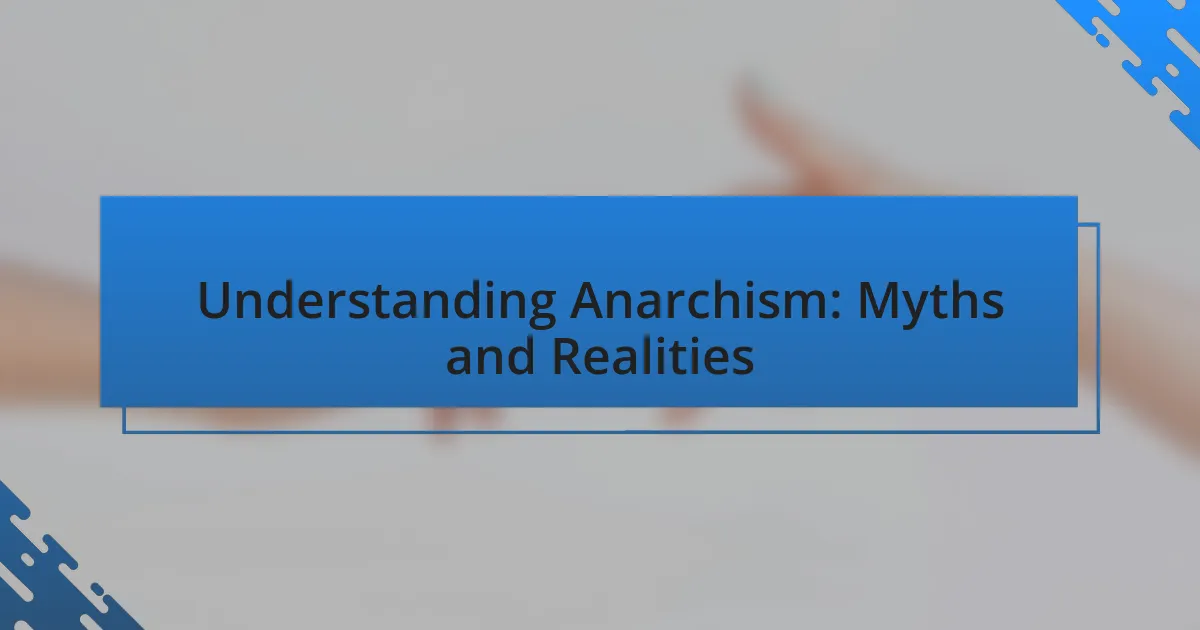Social justice movements are organized efforts aimed at addressing social inequalities and advocating for the rights of marginalized groups, focusing on issues such as race, gender, class, and sexual orientation. The article explores the emergence of these movements in response to systemic injustices, highlighting historical events that have shaped their development, such as the Civil Rights Movement and the Women’s Suffrage Movement. It examines the role of grassroots organizations in mobilizing communities, the political ideologies that underpin these movements, and their strategies for influencing policy and achieving societal change. Additionally, the article discusses the importance of intersectionality in shaping movement goals and the best practices for individuals looking to engage in social justice initiatives.
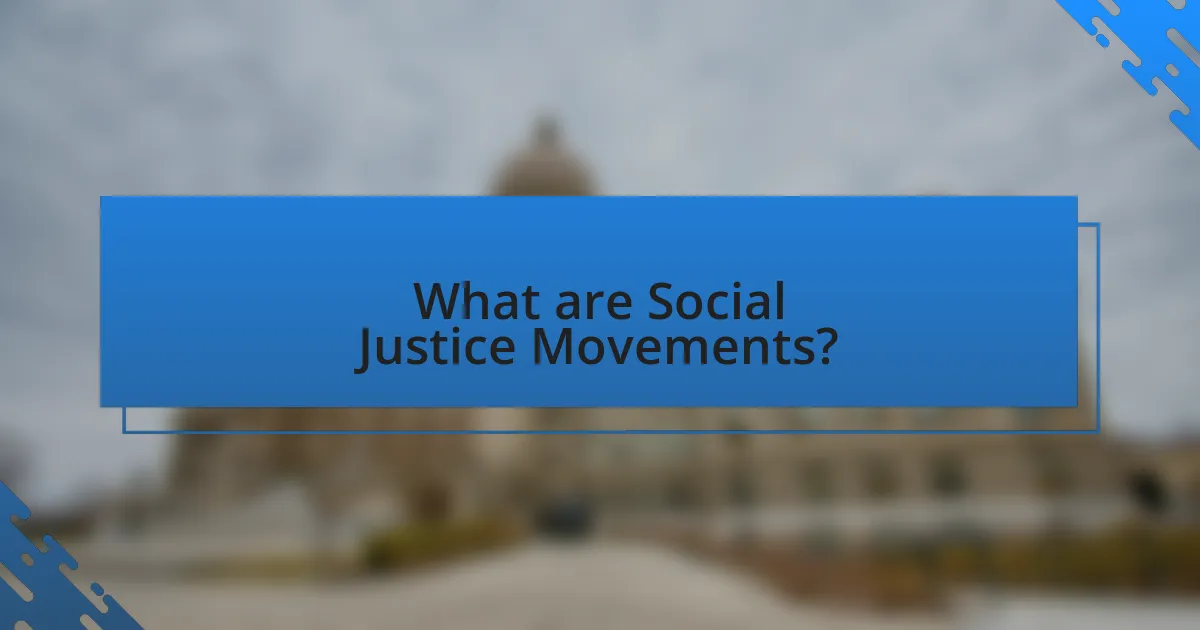
What are Social Justice Movements?
Social justice movements are organized efforts aimed at addressing and rectifying social inequalities and injustices within society. These movements advocate for the rights and equitable treatment of marginalized groups, focusing on issues such as race, gender, class, and sexual orientation. Historical examples include the Civil Rights Movement in the United States, which sought to end racial segregation and discrimination, and the Women’s Suffrage Movement, which fought for women’s right to vote. These movements have significantly influenced legislation and social norms, demonstrating their impact on achieving social change and promoting equality.
How do Social Justice Movements emerge?
Social justice movements emerge primarily in response to systemic inequalities and injustices within society. These movements often arise when marginalized groups mobilize to advocate for their rights and seek to address social, economic, or political grievances. Historical examples include the Civil Rights Movement in the United States, which emerged in the mid-20th century to combat racial discrimination and segregation, driven by widespread activism and grassroots organizing. The emergence of such movements is typically fueled by a combination of social awareness, collective identity, and the desire for change, often catalyzed by specific events or crises that highlight injustices.
What historical events have influenced the rise of Social Justice Movements?
The rise of Social Justice Movements has been significantly influenced by events such as the Civil Rights Movement in the 1960s, which aimed to end racial segregation and discrimination against African Americans in the United States. This movement was marked by key events like the March on Washington in 1963, where Martin Luther King Jr. delivered his “I Have a Dream” speech, galvanizing public support for racial equality. Additionally, the feminist movements of the late 19th and 20th centuries, particularly the suffrage movement, played a crucial role in advocating for women’s rights and gender equality, culminating in the passage of the 19th Amendment in 1920, which granted women the right to vote in the U.S. Furthermore, the Stonewall Riots of 1969 were pivotal in the rights movement, sparking activism for equality and acceptance. These historical events collectively laid the groundwork for contemporary social justice movements by highlighting systemic inequalities and mobilizing diverse groups to advocate for change.
What role do grassroots organizations play in these movements?
Grassroots organizations serve as the foundational backbone of social justice movements by mobilizing community members, fostering local leadership, and advocating for systemic change. These organizations often emerge from the communities they represent, ensuring that the voices of marginalized populations are heard and prioritized. For instance, during the Civil Rights Movement, grassroots groups like the Student Nonviolent Coordinating Committee (SNCC) played a crucial role in organizing protests and voter registration drives, directly influencing legislation such as the Voting Rights Act of 1965. Their ability to engage individuals at the local level empowers communities to challenge injustices and demand accountability from political institutions.
Why are Social Justice Movements important?
Social justice movements are important because they advocate for the equitable treatment of all individuals, addressing systemic inequalities and injustices. These movements have historically played a crucial role in advancing civil rights, promoting social change, and influencing legislation. For instance, the Civil Rights Movement in the United States led to significant legal reforms, such as the Civil Rights Act of 1964, which prohibited discrimination based on race, color, religion, sex, or national origin. This demonstrates how social justice movements can effectively challenge oppressive systems and foster a more inclusive society.
How do they impact societal change?
Social justice movements impact societal change by advocating for the rights and equality of marginalized groups, leading to policy reforms and shifts in public perception. For instance, the Civil Rights Movement in the United States resulted in significant legislative changes, such as the Civil Rights Act of 1964, which outlawed discrimination based on race, color, religion, sex, or national origin. This movement not only transformed laws but also altered societal attitudes towards race and equality, demonstrating the profound influence of organized activism on both policy and cultural norms.
What are the key achievements of Social Justice Movements?
Social Justice Movements have achieved significant milestones, including the advancement of civil rights, gender equality, and rights. For instance, the Civil Rights Movement in the United States led to the Civil Rights Act of 1964, which prohibited discrimination based on race, color, religion, sex, or national origin. Additionally, the women’s suffrage movement culminated in the 19th Amendment, granting women the right to vote in 1920. Furthermore, the rights movement has resulted in landmark legal decisions, such as the Supreme Court’s ruling in Obergefell v. Hodges in 2015, which legalized same-sex marriage nationwide. These achievements reflect the movements’ impact on legislation and societal norms, promoting equality and justice across various demographics.
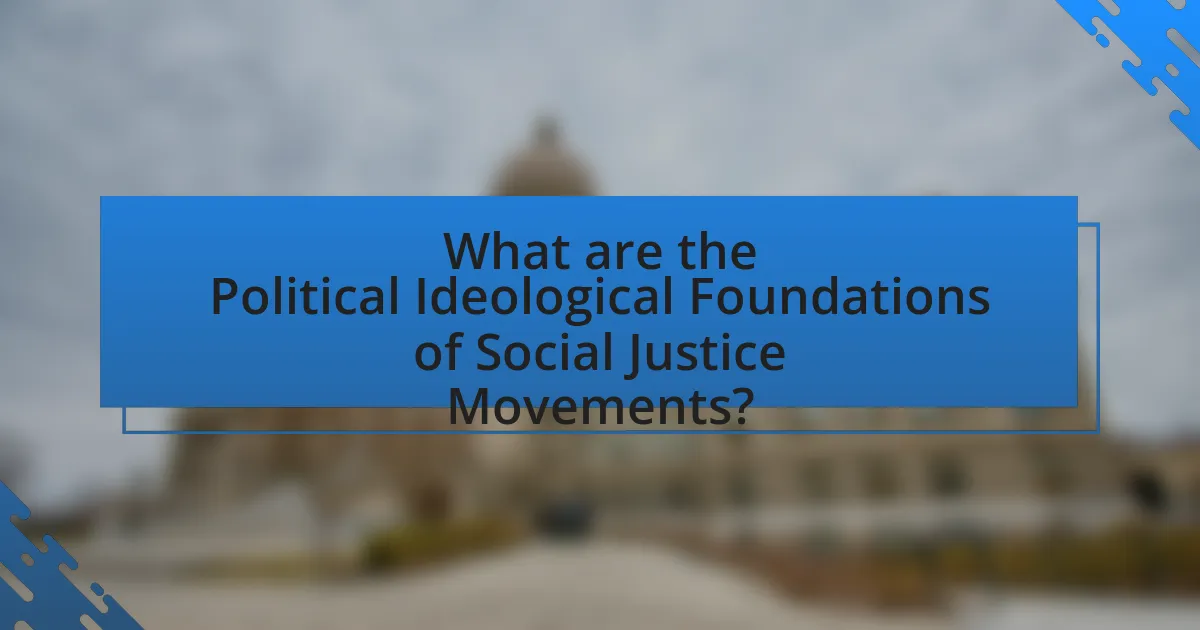
What are the Political Ideological Foundations of Social Justice Movements?
The political ideological foundations of social justice movements primarily include liberalism, socialism, and critical theory. Liberalism emphasizes individual rights and equality, advocating for systemic reforms to address social injustices. Socialism focuses on economic equality and collective ownership, aiming to dismantle capitalist structures that perpetuate inequality. Critical theory, particularly from the Frankfurt School, critiques societal norms and power structures, promoting a transformative approach to social issues. These ideologies collectively inform the strategies and goals of social justice movements, as evidenced by historical examples such as the Civil Rights Movement, which drew on liberal principles of equality and justice, and the labor movement, which was rooted in socialist ideals advocating for workers’ rights.
How do different political ideologies shape Social Justice Movements?
Different political ideologies shape social justice movements by influencing their goals, strategies, and the issues they prioritize. For instance, liberal ideologies often focus on individual rights and equality, advocating for reforms within existing systems, as seen in movements for rights and gender equality. In contrast, socialist ideologies emphasize collective action and systemic change, prioritizing economic justice and workers’ rights, which is evident in labor movements and anti-capitalist protests. Furthermore, conservative ideologies may resist social justice movements by emphasizing tradition and social stability, often opposing changes that challenge established norms. Historical examples include the civil rights movement, which was driven by a mix of liberal and radical ideologies, showcasing how diverse political perspectives can converge to address social injustices.
What is the relationship between liberalism and Social Justice Movements?
Liberalism and Social Justice Movements are interconnected as both advocate for individual rights, equality, and social reform. Liberalism emphasizes the protection of individual freedoms and the promotion of equal opportunities, which aligns with the goals of Social Justice Movements that seek to address systemic inequalities and advocate for marginalized groups. Historical examples include the civil rights movement in the United States, which drew upon liberal principles of equality and justice to challenge racial discrimination. Additionally, contemporary social justice initiatives often utilize liberal frameworks to push for policy changes that promote equity in areas such as education, healthcare, and economic opportunity.
How do socialist ideologies influence these movements?
Socialist ideologies significantly influence social justice movements by promoting principles of equality, collective ownership, and social welfare. These ideologies advocate for systemic changes to address economic disparities and empower marginalized communities. For instance, the labor movements of the early 20th century, heavily influenced by socialist thought, fought for workers’ rights, leading to the establishment of labor laws and protections that benefit the working class. Additionally, contemporary movements, such as Black Lives Matter, often incorporate socialist elements by emphasizing the need for structural change to combat systemic racism and economic inequality, reflecting the belief that social justice is inherently linked to economic justice.
What are the common goals across various Social Justice Movements?
Common goals across various social justice movements include the pursuit of equality, equity, and the protection of human rights. These movements aim to dismantle systemic oppression and discrimination based on race, gender, sexual orientation, and socioeconomic status. For instance, the Civil Rights Movement in the United States sought to end racial segregation and ensure voting rights for African Americans, while the rights movement advocates for equal rights and protections for individuals regardless of sexual orientation or gender identity. Additionally, environmental justice movements focus on addressing the disproportionate impact of environmental hazards on marginalized communities. These goals are interconnected, as they all strive to create a more just and inclusive society, reflecting the fundamental principle that all individuals deserve equal treatment and opportunities.
How do these goals reflect the underlying political ideologies?
The goals of social justice movements reflect underlying political ideologies by advocating for equality, equity, and systemic change, which are central tenets of liberalism and progressivism. For instance, movements focused on racial justice emphasize dismantling institutional racism, aligning with the liberal ideology that promotes individual rights and social equity. Similarly, goals related to economic justice, such as wealth redistribution and workers’ rights, resonate with socialist ideologies that prioritize collective welfare and challenge capitalist structures. Historical examples include the Civil Rights Movement, which sought to achieve legal equality and social integration, reflecting the liberal belief in equal rights for all citizens. These movements illustrate how their specific goals are rooted in broader ideological frameworks that seek to address power imbalances and promote social change.
What role does intersectionality play in shaping these goals?
Intersectionality plays a crucial role in shaping the goals of social justice movements by highlighting how various forms of discrimination and privilege intersect to affect individuals’ experiences. This framework allows activists to understand that issues such as race, gender, class, and sexuality do not exist in isolation; rather, they combine to create unique challenges for marginalized groups. For example, the Combahee River Collective, a group of Black feminists, articulated in their 1977 statement that the liberation of all oppressed people requires an understanding of how these intersecting identities impact their lives. This understanding informs the goals of social justice movements, ensuring they address the complexities of inequality rather than adopting a one-size-fits-all approach.
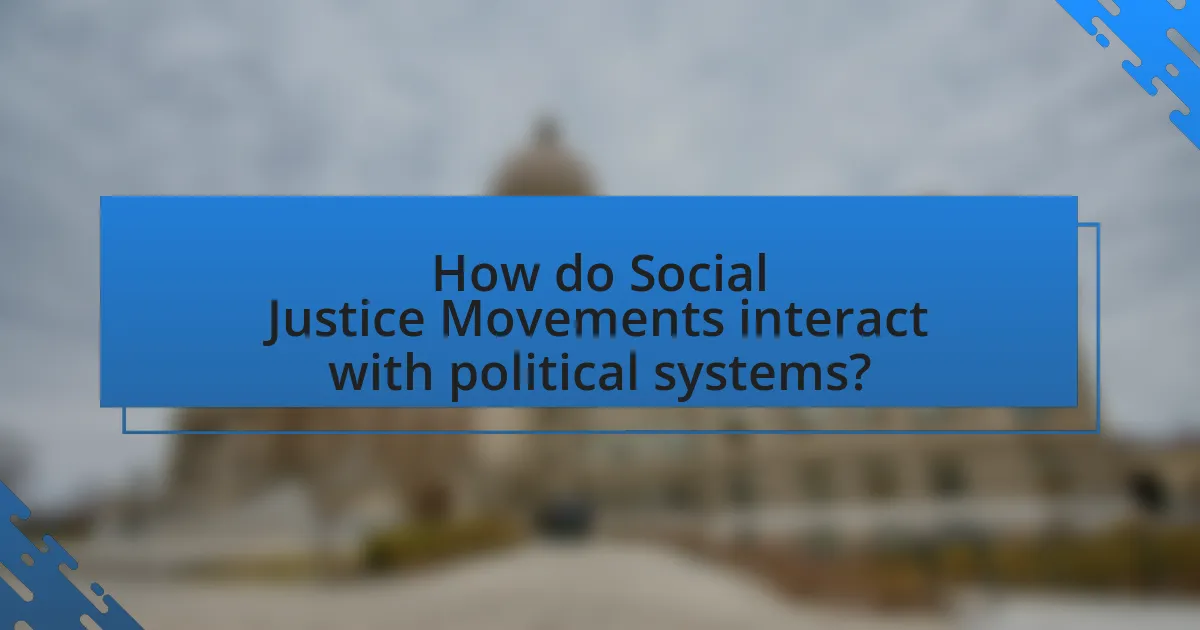
How do Social Justice Movements interact with political systems?
Social justice movements interact with political systems by advocating for policy changes, influencing legislation, and mobilizing public opinion. These movements often emerge in response to perceived injustices and seek to address issues such as inequality, discrimination, and human rights violations. For instance, the Civil Rights Movement in the United States led to significant legislative changes, including the Civil Rights Act of 1964 and the Voting Rights Act of 1965, which were direct responses to the demands of activists. Additionally, social justice movements utilize various strategies, including protests, lobbying, and grassroots organizing, to engage with political entities and push for reforms that align with their goals. This interaction can lead to shifts in political priorities and the establishment of new policies that reflect the values and demands of these movements.
What strategies do Social Justice Movements use to influence policy?
Social justice movements use strategies such as grassroots organizing, advocacy, coalition-building, and public awareness campaigns to influence policy. Grassroots organizing mobilizes community members to participate in collective action, which can lead to significant political pressure. Advocacy efforts often involve lobbying policymakers and engaging in direct dialogue to promote specific legislative changes. Coalition-building allows diverse groups to unite around common goals, amplifying their collective voice and impact. Public awareness campaigns leverage media and social platforms to educate the public and garner support for policy initiatives, as seen in movements like Black Lives Matter, which effectively raised awareness about systemic racism and police reform. These strategies have historically led to tangible policy changes, such as the Civil Rights Act of 1964, which was influenced by sustained activism and advocacy efforts.
How effective are protests and demonstrations in achieving political change?
Protests and demonstrations are highly effective in achieving political change, as evidenced by numerous historical examples. For instance, the Civil Rights Movement in the United States led to significant legislative changes, including the Civil Rights Act of 1964 and the Voting Rights Act of 1965, largely driven by mass protests and demonstrations. Additionally, the Arab Spring, which began in 2010, resulted in the overthrow of several authoritarian regimes in the Middle East and North Africa, showcasing how collective action can lead to substantial political transformations. Research indicates that sustained protests can increase public awareness and pressure political leaders to respond to demands, thereby facilitating change.
What role does lobbying play in the success of Social Justice Movements?
Lobbying plays a crucial role in the success of social justice movements by influencing policymakers and shaping public policy to align with the movement’s goals. Effective lobbying efforts can lead to the introduction of legislation that addresses social inequalities, as seen in the Civil Rights Movement, where organized lobbying contributed to the passage of the Civil Rights Act of 1964. Additionally, lobbying helps to mobilize resources, build coalitions, and raise awareness, which are essential for sustaining momentum and achieving long-term objectives. Research indicates that movements with strong lobbying efforts are more likely to secure legislative victories and public support, demonstrating the significant impact of lobbying on the effectiveness of social justice initiatives.
How do Social Justice Movements respond to political opposition?
Social justice movements respond to political opposition through organized advocacy, public demonstrations, and strategic coalition-building. These movements often mobilize supporters to raise awareness and apply pressure on political entities, utilizing tactics such as protests, social media campaigns, and lobbying efforts to challenge opposing narratives and policies. For instance, the Black Lives Matter movement has effectively used protests and social media to highlight systemic racism and police brutality, influencing public discourse and prompting legislative discussions on police reform. Additionally, social justice movements frequently engage in grassroots organizing to build alliances with other marginalized groups, thereby amplifying their collective voice against political resistance.
What tactics are employed to counteract resistance from political entities?
Social justice movements employ various tactics to counteract resistance from political entities, including grassroots mobilization, coalition-building, strategic litigation, and public awareness campaigns. Grassroots mobilization involves organizing community members to participate in protests and demonstrations, which can exert pressure on political entities to respond to demands. Coalition-building allows movements to unite with other organizations, amplifying their voice and increasing their influence. Strategic litigation targets specific laws or policies through the judicial system, seeking to challenge and change unjust practices. Public awareness campaigns utilize media and social platforms to educate the public and garner support, thereby creating a broader base of advocacy that can influence political decision-making. These tactics have been effective in various historical contexts, such as the Civil Rights Movement, where coordinated efforts led to significant legislative changes.
How do movements adapt their strategies in response to changing political climates?
Movements adapt their strategies in response to changing political climates by reassessing their goals, tactics, and messaging to align with the current socio-political environment. For instance, during periods of increased repression, movements may shift from public demonstrations to more covert forms of activism, such as digital organizing or community-based initiatives, to avoid state surveillance and backlash. Historical examples include the Civil Rights Movement, which adjusted its strategies in response to both legislative changes and public sentiment, utilizing nonviolent protests when public support was favorable and shifting to more radical approaches when faced with systemic violence. This adaptability is crucial for maintaining relevance and effectiveness in achieving their objectives amidst fluctuating political landscapes.
What are best practices for engaging in Social Justice Movements?
Best practices for engaging in social justice movements include educating oneself on the issues, actively listening to marginalized voices, and participating in community organizing. Educating oneself involves understanding the historical context and current dynamics of social justice issues, which can be supported by resources such as books, documentaries, and academic articles. Actively listening to marginalized voices ensures that the movement is inclusive and representative, fostering a sense of community and solidarity. Participating in community organizing allows individuals to collaborate on initiatives that address specific social justice goals, as seen in successful movements like the Civil Rights Movement, which utilized grassroots organizing to effect change.
How can individuals effectively contribute to Social Justice Movements?
Individuals can effectively contribute to social justice movements by actively participating in advocacy, education, and community organizing. Advocacy involves supporting policies that promote equity and justice, such as lobbying for legislative changes that address systemic inequalities. Education plays a crucial role, as individuals can raise awareness about social justice issues through workshops, discussions, and social media campaigns, thereby informing and mobilizing others. Community organizing empowers individuals to unite local efforts, fostering collective action that can lead to significant social change. Historical examples, such as the Civil Rights Movement, demonstrate that grassroots organizing and sustained advocacy can lead to transformative policy changes, highlighting the effectiveness of individual contributions in larger movements.
What resources are available for those looking to get involved?
Various resources are available for individuals looking to get involved in social justice movements, including online platforms, community organizations, and educational materials. Websites such as Idealist and VolunteerMatch connect volunteers with local organizations focused on social justice issues. Additionally, organizations like the American Civil Liberties Union (ACLU) and the Southern Poverty Law Center (SPLC) provide opportunities for activism, education, and advocacy. Educational resources, including books and online courses, are also available to deepen understanding of social justice topics and strategies. These resources collectively empower individuals to engage effectively in social justice initiatives.
